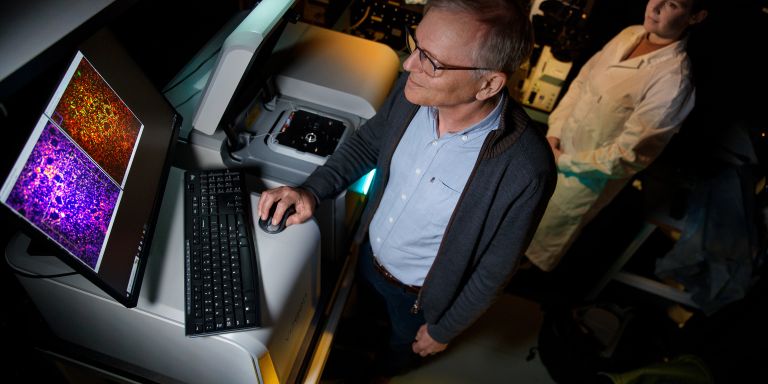
Patrik Ernfors
Professor of Tissue Biology
Wallenberg Scholar
Institution:
Karolinska Institutet
Research field:
Cells and mechanisms that cause chronic pain


Wallenberg Scholar
Institution:
Karolinska Institutet
Research field:
Cells and mechanisms that cause chronic pain
Pain is a double-edged sword. Perception of pain is essential because it helps us to avoid danger. Yet pain also causes a great deal of suffering – particular when it is chronic. About one person in five over the age of 20 suffers from chronic pain, and about eight percent experience so much pain that it affects their daily lives.
“Chronic pain has a huge impact on our day-to-day lives, causing chronic fatigue, among other things. If you suffer from chronic pain, your whole life tends to revolve around that pain,” says Ernfors, who is professor of tissue biology at Karolinska Institutet.
We still do not have good enough drugs to treat pain. In particular, we lack therapeutics to alleviate chronic pain. This is because the mechanisms underlying pain are highly complicated.
“Only when we understand what lies behind how pain is sensed will we be able to understand what goes wrong when we suffer chronic pain.”
Sensitivity to pain is a fantastic thing, protecting us from the dangers of life. It’s hard to survive without it, but sometimes the pain itself can become quite unbearable.
For several decades now Ernfors has been studying development of the nervous system, from stem cells to the various kinds of cell that make up the central and the peripheral nervous system. His research now has a sharp focal point on the somatosensory nervous system and pain research.
The sensory nervous system ensures that signals from our senses – sight, hearing, smell, taste and touch – reach the brain. The somatosensory nervous system conveys the sense of touch. Apart from transmitting touch, it also enables us to perceive pain and a wide range of sensations – from temperature to the position of one’s legs and arms.
Ernfors aims to ascertain which somatosensory neurons cause pain, for example as a result of rheumatic disease or nerve damage. A further goal is to identify the kinds of neurons that are involved when pain becomes chronic or leads to various forms of hypersensitivity – to heat, cold or physical pressure, for instance.
“We need to find out which cell types are involved, and also create disease models that enable us to examine what goes wrong in those cells. Only then will we gain a better understanding of sensitivity to pain,” Ernfors says.
Technological developments in recent years have given him multiple new tools to use in his search. One of them is the ability to catalog cells using single-cell RNA analysis, in which the RNA content of individual cells is analyzed in detail. There are now also techniques to examine chromatin – DNA structure – itself in the cell nucleus. The aim is to identify changes in gene expression in the neurons that cause various kinds of chronic pain.
“By 2015 we’d managed to create a molecular map of neurons based on their gene expression, and we now have techniques that enable us to add more layers to the map, giving it a higher definition than previously. The more details we can see, the greater our understanding.”
Single-cell RNA analysis enables researchers to create 3D models on a large scale, revealing where a given kind of cell is found in the body. Ernfors shows us around the lab by way of demonstration. A computer monitor displays a model of the brain that can be rotated in three dimensions and zoomed in on. An aggregation of neurons is highlighted in a section of the brain – a result of the analysis itself.
“It’s the first time ever that we can so easily see how the cells are gathered together,” he says, and asks the PhD student at the screen to document the images for future publication.
Once the right cells have been identified, he hopes simply to be able to turn them off using gene therapy. Turning off only the cells that cause chronic pain will enable other essential aspects of sensitivity to pain to be retained.
“We hope to turn them off using our knowledge from the DNA analysis. We know that if we find unique traits in the DNA of pain-causing cells, we can use them to control cell activity with the help of drugs.”
Scientists already know enough to fuel hopes of finding a therapy to eliminate the pain caused by rheumatoid arthritis. Ernfors emphasizes that this is largely due to strenuous efforts made by many research teams over the past twenty years.
Somewhat unexpectedly, the research saw an upswing following the recent Covid pandemic. This is because the technique developed to introduce tiny fragments of mRNA into the body to fight the virus can also be used here.
“We want to modify the technique so we can reach the neurons we want to control using our gene regulation techniques. This will give us a way of switching off selected neurons completely, thereby liberating people from unnecessary pain.”
Text Magnus Trogen Pahlén
Translation Maxwell Arding
Photo Magnus Bergström